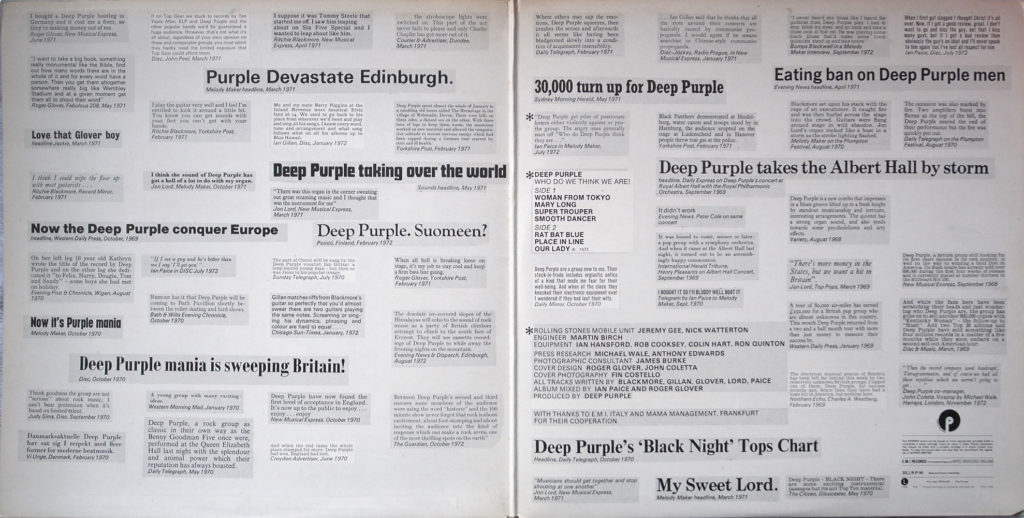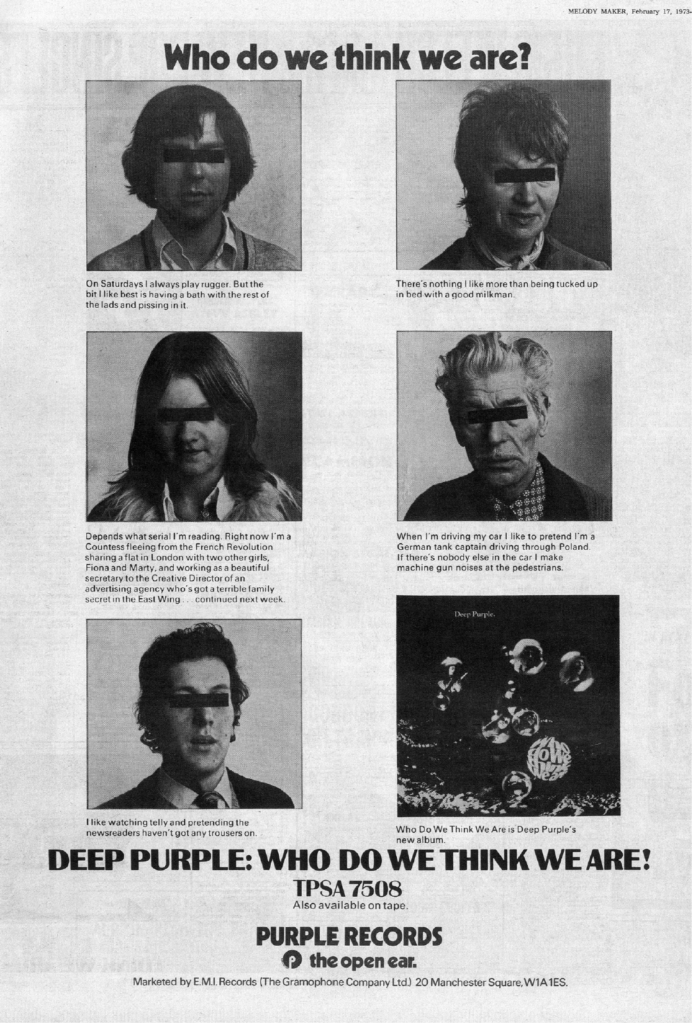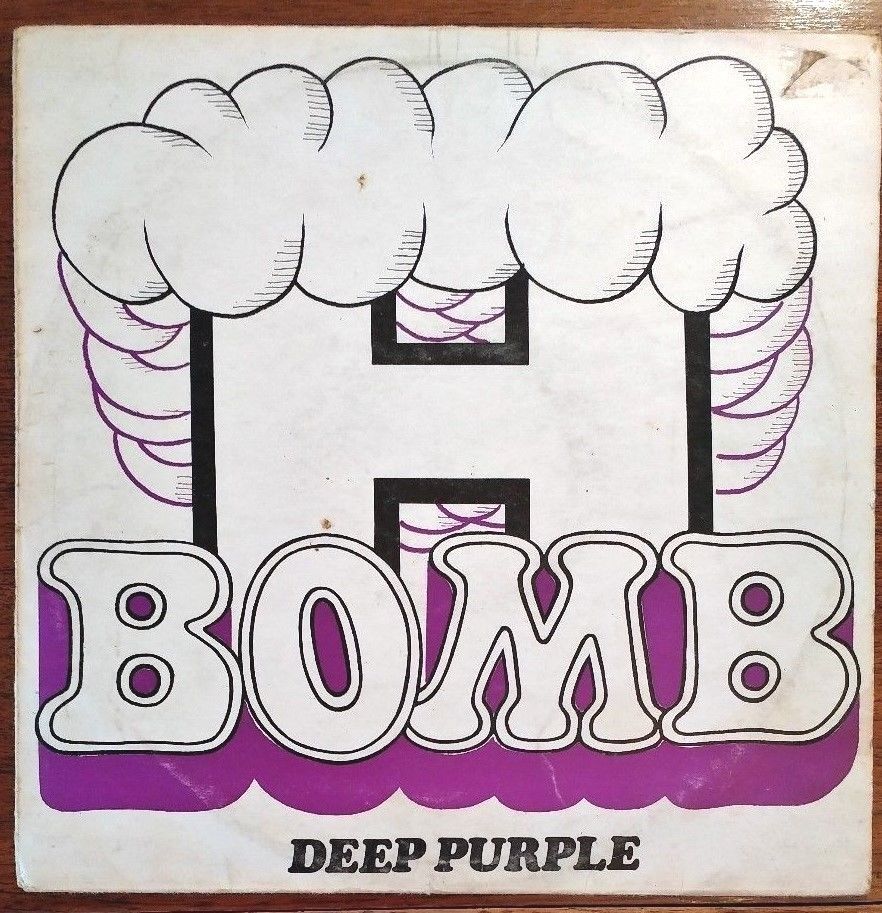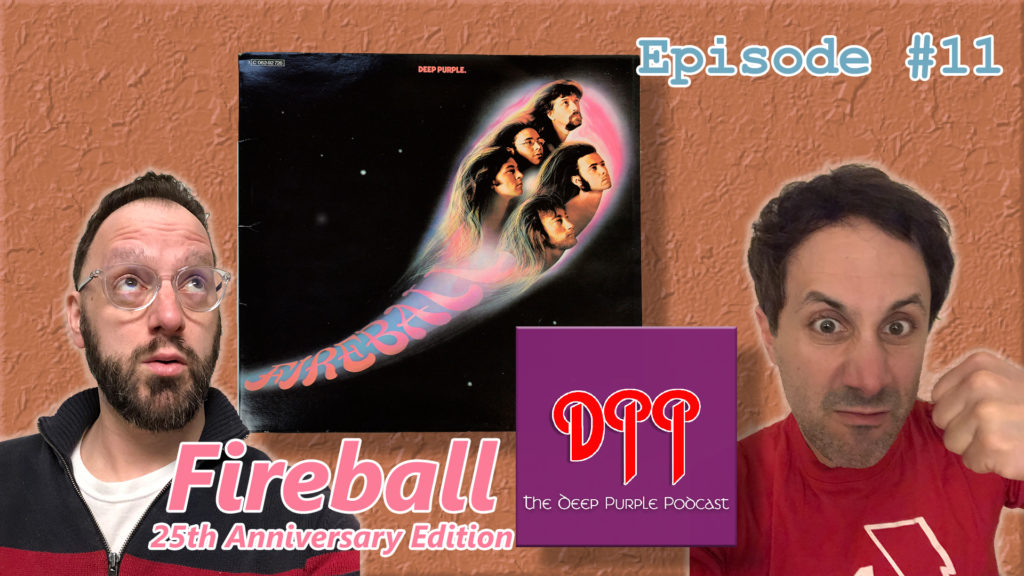Subscribe at Apple Podcasts, Stitcher, Spotify, Google Podcasts, Overcast, Pocket Casts, Anchor.fm, Breaker, PodBean, RadioPublic, or search in your favorite podcatcher!
Show Updates:
- Thanks to @JoergPlaner on Twitter for coming through with our request for the NME review of “Burn” in record time!
- We’re now on Spotify !
Thanks to Our Patrons:
- Clay Wombacher
- Steve Seaborg
Lead Up To Album & Writing:
- They began recording in July of 1972 just a month before performing “Made in Japan.” Only Woman From Tokyo would make the album. They completed the album upon returning from Japan in October.
- Woman From Tokyo was written before they’d ever been to Japan.
- In the US they were more interested in the next studio album.
- They recorded Who Do We Think We Are but since Made in Japan was “The ‘Machine Head Album’ they decided to release that first (in December) while Who do we think we are was released a month later in January of 1973.
- Eventually Warner Bros. released it internationally because Deep Purple’s management was importing copies into the United States and they were losing out on not releasing it.
- The band flew to the States four times in the first six months of 1972 as well as doing European dates. Almost everyone in the band had suffered from fatigue and serious illnesses.
- When they stopped touring in July to begin recording they rented a villa near Rome.
- Roger Glover says they had a supply of good cheap local red wine and hundreds of bottles were delivered at the start of recording.
- The villa had a living room, dining room, five or six bedrooms, a patio, a swimming pool. They recorded in what Glover called “the feasting room.”
- The first problem was that the mobile wouldn’t fit through the archway to the villa so they had to go out and buy extra long cables.
- They had to walk a third of a mile to listen to the takes.
- The equipment was all late so the first day was spent drinking wine. There was an old piano in the room that they used to have a singalong.
- The first night there Glover writes about the cook bringing in the meal: “As evening fell, the cook, a dentally challenged woman who would soon be known affectionately as Fang, served the pasta and we all continued dipping into the copious supply of wine and grappa, confident that we were in good shape and that when the gear eventually arrived we would have a lot of fun making this album.”
- They spent three weeks doing not much other than playing cards, drinking wine, swimming in the pool, and eating meals prepared by Fang.
- Blackmore refused to stay in the house with the others and often didn’t come to the sessions at all.
- Gillan: “I remember the joys of the local red wine, the underwater swimming championships in the pool and the eternal frustrations of trying to perform as a band while 20 per cent short in number…”
- The sessions on produced two songs, “Woman From Tokyo” and “Painted Horse” which Ritchie hated and would not allow on the album.
- Gillan write in “Child in Time” about a third song “Smelly Botty.” This was supposedly sung by Jon Lord.
- Ian Gillan also did a cover of Conway Twitty’s “Its Only Make Believe.” with the band singing backup vocals.
- Blackmore was trying to recruit Paul Rodgers to replace Gillan and trying to launch Baby Face who had done some demos. There were even rumors that Blackmore was trying to get Rodgers to front Baby Face.
- Thin Lizzy would release a Deep Purple tribute album in 1972.
- Glover, in an interview with Steve Pilkington, quoted Paul McCartney’s line about the album “Let it Be.” “It was 90% enjoyable but everyone wanted to focus on the 10%.”
- Glover: “That’s how it was with Ritchie — a lot of the time it was fine, we had a great time, and it was a really good dynamic, it wasn’t these constant arguments that people imagine. The thing with Ritchie though is that while he’s a great, gifted musician, he’s not a natural team player.
- Glover talks about starting up a riff and they’d all join in and say let’s do it but Ritchie would say he was saving that for his solo album.
- I wonder if any of that was stuff that ended up on Burn.
- Italian journalists showed up and saw Glover, Lord and Gillan set up to record in one room with Blackmore and Paice in a garage. There were fights that were witnessed and one Italian paper wrote, “if Deep Purple are always like this, a split cannot be far away.”

Album Art & Booklet Review
- Title of the album. Ian Paice said: “Deep Purple get piles of passionate letters either violently against or pro the group. The angry ones generally start off “Who do Deep Purple think they are…”
- Another such letter was criticizing Paice for kicking over his drums at the end of a performance. Ian said: “I bought it so I’ll bloody well boot it!”
- Cover designed by Roger Glover with John Coletta. Photography is by Fin Costello.
- Uriah Heep
- Trapeze
- Nazareth
- Budgie
- Kiss (Alive!)
- Aerosmith
- Rainbow
- The Jackson Five
- Many, many more on his entry on Fin Costello on Discogs.
- Cover described as a “stormy sky” which is fitting given the state of the band.
- It’s actually an image from a NASA satellite that was used.
- Original idea for the cover was cardboard cutouts of all the band members propped up like mannequins as if fame and fortune had somehow turned them into “merely images.”
- Roger said he didn’t care for the cover design they wound up with.

- Gatefold of album features news clippings about the band to keep with the theme of the album title.

- Ad to promote the album ran in Melody Maker on February 17, 1973. There were also teaser ads throughout the magazine. The record company seemed to be making more of an effort to promote the album. Theory is that they knew Deep Purple was doomed and they wanted to make sure they got the maximum back on their investment.
Album Details and Analysis:
- Album was more of a turn to blues-based music.
- It took longer to record because they had to arrange schedules to record parts when certain band members weren’t present.
- Woman From Tokyo
- Gillan heard the guitar and sang “TO-KY-O!” to match and he and Glover finished the rest of the lyrics imagining what it would be like on their upcoming trip to Japan. An imaginary love affair with a woman in Tokyo that Ian and Roger hoped they would meet.
- Glover states: “The lyrics spoke authoritatively about something we knew very little about at that time.”
- Only song on the album recorded at the villa in Italy.
- Written in advance of going to Japan (where they recorded Made in Japan) though many people think it was inspired by their trip to Japan as this album came out after Made in Japan.
- Refers back to another song, “Black Night”
- Single was a hit. Achieved gold status faster than any previous single in the US (three months). Was not released in the UK. It was scheduled for release but was never released.
- They never played it in Japan. They never played it live until Deep Purple reformed in the 80s.
- Was their most well known song off this album.
- Song cost £8000 for the whole session, as much as the entire Machine Head album.
- Avery Molek – Woman From Tokyo (Drum Cover)
- Mary Long
- The Story Behind The Song: Mary Long by Deep Purple
- This song was in their live set which is odd given the absence of “Woman From Tokyo.”
- Was recorded in October using the mobile unit near Frankfurt.
- Combination of names: Mary Whitehouse and Lord Longford.
- Glover said they got the newspaper delivered at the studio:
- “We had English papers delivered at the studio so we kept up with the news and those were the two people that got up our noses. It seemed that it was all getting much too pro-censorship and pro-do-gooder.”
- Whitehouse’s pregnancy was announced in the newspapers. Glover: “Ian Came up with a great line: ‘We really didn’t know you’d had it in you’ — ever the master of the double-entendre!”
- Mary Whitehouse
- English social activist who felt that the liberal media had encouraged the youth of Britain to be more sexually promiscuous.
- Founder and president of the NAtional Viewers’ and Listeners’ Association.
- Opposed feminism, gay rights, and the sexual revolution.
- She was against Doctor Who, Benny Hill, and the series “Till Death Do Us Part” A particular favorite of Ian Gillan’s. “Mary told Johnny not to write such trash . . .” reference to Johnny Speight, the creator of the show.
- Lord Longford
- Mary Whitehouse’s ally in government.
- He was instrumental in decriminalizing homosexuality in the UK but later became a staunch opponent of homoosexuality calling it “utterly wrongful.”
- He was kind of incompetent, being moved around from one position to another by his own party.
- Labor Prime Minister Harold Wilson said that Longford had the “mental capacity of a 12-year old.”
- He was discovered attending strip clubs thus the “porny lord” reference and claims of hypocrisy as he was very vocally speaking out against all forms of adult entertainment.
- Gillan recalls: “Mary Whitehouse and Lord Longford were particularly high-profile figures at the time with very waggy-waggy finger attitudes. On reflection, it’s a little bit unfair because the generation before – in the post-war period – were extremely generous to us. But it’s just natural to rebel.
- “Mary Long grew out of the whole idea of dealing with an imaginary person. It was about the standards of the older generation, the whole moral framework, intellectual vandalism – all of the things that exist throughout the generations.
- “I had a lot of issues with the religion that I grew up with, but as I found out later, those issues exist in all religions, so Mary Whitehouse and Lord Longford became one person – fusing together – to represent the hypocrisy that I saw at the time.
- “So there I was slinging names about and accusing them of all sorts of things – dastardly deeds and vile occurrences! The idea was that we are young, we are naked and therefore we are truthful. I never met a 20-year-old who didn’t think they were immortal and didn’t lack an opinion on everything – it was that sort of time.”
- This is the only song from the album the band performed live. The band projected pornographic images to convey the message of the song. This was only played live for about two dozen shows.
- Even Blackmore said this was one of the best tracks on the album.
- Super Trouper
- A Deep Purple song under 3 minutes!
- Titled after the name of the big spotlights used at the time.
- Glover had been thinking of Freddie King’s song ‘Going Down’ when he wrote the riff.
- “I was a young man when I died.” Inspired by deaths of Jimi Hendrix and other rockers at a young age.
- Smooth Dancer
- Gillan: “I admit taking my anger out on Ritchie in particular, and did so in the only way I knew best – hidden in the lyrics. ‘Smooth Dancer’ is an example of this, with frequent references to black suede, his favourite clothing. Unfortunately, I don’t think he saw the subtlety, which made me even more angry!”
- Black suede is a reference to Ritchie’s “man in black” persona.
- References Blackmore’s attempts to force Ian out. Ian declares that instead he’s going to “Walk to freedom.”
- It’s actually a pretty touching song when you read the lyrics. Both angry and sad.
- Glover: “It’s illuminating to read those lyrics and realise what was going through Ian’s mind. He wasn’t going to take what Ritchie was handing out but at the same time he wanted to be friends with him again.”
- Rat Bat Blue
- Reportedly about Gillan’s misogynistic tendency to “use and discard” groupies.
- Organ/key solo is a stand out.
- The title of the song may be from the name Ian Paice gave a drum fill that he used to warm up. The words “Rat Bat Bat Bat Blue” match the hits on the snare drum.
- Glover’s favorite track of the album. Glover: “About picking up a loose chick for the night.”
- Refers back to “Hard Loving Man.”
- Roger Glover says Ritchie was bored with their normal solo structure and just gave the solo to Jon.
- Place in Line
- Filler song.
- Straight blues number.
- About the rat race of the music business.
- “Nine long years” could be his reference to the music business and his desire to leave.
- Inspired by a concept in a sci-fi novel which Glover read and passed to Gillan. It’s about the repetitive life they lead at the time.
- Our Lady
- Heard it compared to “I Am The Walrus.”
- No guitar solo.
- Ian Paice believed and was quoted as saying the band was “finding it harder to come up with killer riffs.”
- Blackmore came up with the title for this song after walking by a church of the same name.
- Lord: ““Our Lady might be quite surprising, for a start it’s very slow and concentrates more on the tune and the lyrics and there are no solos. It’s just a song, which is not normally the way Deep Purple seems to work.”
Reception and Review
- Ian Paice viewed the album as the band moving forward: “there’s more melody and more electronic effects without losing any of the guts.
- Lord was also happy: “If you don’t do what they expect people cry ‘cheat’ and if you do what they expect they should ‘formula; at you. There’s obviously a nice middle passage between those two and that’s what we’ve tried to get on this album.”
- Glover tells a story of The Wasp being a karate student. He was practicing his punch when Ian Gillan decided he’d show Martin how much harder he could punch. He ended up breaking his hand. They had to re-break it and set it in a cast and to this day he has no knuckle on the little finger of his right hand which Glover describes as “an odd legacy of the album.”
- Album received mixed reviews.
- UK Music Paper Review (positive): http://www.deep-purple.net/review-files/68-76/68-76mk2a.htm
- Rolling Stone Review by Ann Cheauvy April 12, 1973 (negative): https://www.rollingstone.com/music/music-album-reviews/who-do-we-think-we-are-249952/
- Now if I really wanted to get picky, I could point to the “join the crowd” moog solo on “Rat Bat Blue.” What a cliched instrument the synthesizer has turned out to be — even boogie monsters like TYA’s Chick Churchill are playing around with it. And speaking of Churchill, Lord manages to sound just like him on the Purple blooze, otherwise known as “Place In Line.” It’s sorta like a sound sleep imitating a coma. And then (then) there’s “Smooth Dancer,” where they rhyme “dancing” with “pregnancy” in a chauvinistic power play that curdled every drop of Women’s Lib blood in my veins.
- Well, at least “Super Trouper” ain’t half bad, but how can you possibly fault a song with such a nifty title? For that matter, how can you slam a group that makes an album like In Rock? It’s easy when their three follow-ups get you wondering if it’s the same group — real easy.
In The News . . .
- Rick Wakeman remembers keyboard compatriot Jon Lord
- Rick Wakeman and Jon Lord on Sunflower Jam 2011
- They couldn’t decide whether to do one of Jon’s pieces or Rick’s pieces so they wrote something together. A piece called “It’s Not As Big As It Was.”
- David Coverdale ‘Felt Presence’ of Jon Lord in Whitesnake Remix: Exclusive Interview
- From March 2019
- Talks about remastering “Slide it In” 35th anniversary edition
- “What was the most amazing thing for me, was while we were remixing this in the studio, I felt the presence of [guitarist] Mel Galley, [drummer] Cozy Powell and [keyboardist] Jon Lord,” he recalls. “Half the band that made that record have passed away.”
- “Chris turned ’round to me, he said, ‘Are you okay?’ I said, ‘My God, I can so feel their energy in here.’ And he goes, ‘Oh my God, I hope it’s positive.’ I went, ‘Oh, it’s absolutely positive.’ And I just felt them — I could see them standing here, behind us, like, hands on his shoulders and my shoulders as we were mixing. Hearing the individual performances, like from 24-track analog transfers to digital … hearing Jon Lord’s sound on its own, and then hearing Cozy Powell’s immense drum sound — …. It was wonderful. It was touching. It was rewarding. It just made the project fresh and exciting for me.”
This Week in Purple History . . .
July 29 through August 4
- August 1, 1951 – Tommy Bolin is Born
- August 2, 1951 – Joe Lynn Turner is born
- August 3, 1975 – Deep Purple begin recording Come Taste The Band
- August 1, 1977 – Captain Beyond release their third and final album “Dawn Explosion” without Rod Evans. They tried to contact him but couldn’t find him. Willy Daffern replaced him. Was in a band called “Hunger.”
For Further Information:
- Deep Purple: A Matter of Fact by Jerry Bloom
- Smoke on the Water: The Deep Purple Story
- The Road of Golden Dust: The Deep Purple Story 1968-1976 by Jerry Bloom
- Child in Time by Ian Gillan
- Deep Purple: Complete Uk Vinyl Discography 1968-1982 By Neil Priddey
Listener Mail/Comments
- Comments about the show? Things you’d like us to cover? We’d love to hear from you. Send us an email at info@deeppurplepodcast.com or @ us on Twitter, Facebook, or Instagram.








